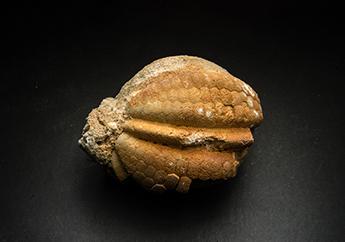Missouri Geological Survey Director: Carey Bridges, RG
Regular Echinoids comprise a group of echinoderm spiny-skinned, marine, invertebrate animals having rigid, protective shells composed of numerous, tightly joined ossicles (spine-bearing pieces). They include sea urchins and pencil urchins that have protective shells with the mouth centered on the bottom.

Regular echinoids are well represented in the oceans of today. Their fossil record dates back to Paleozoic Ordovician time (450 million years ago). One group of regulars, the Cidaroida, survived the mass extinction event at the end of Paleozoic time (250 million years ago), and it gave rise to the many different kinds of echinoids that exist today.
Regular echinoids are bottom dwellers at ocean depths ranging from intertidal (between the low-water and high-water mark) to abyssal (immeasurable). They prefer a firm surface on which they slowly wander around using their spines, like walking on stilts. Echinoids living in intertidal and wave surf settings have thick, club-like spines that keep them from being rolled or swept along by currents. Some of them cling to and climb sea cliffs using their suction cup and prehensile tube feet. Other regulars reside in rock cavities, anchoring themselves inside with extended, suction-cup tube feet and making the cavity larger as they grow by abrading the cavity with their spines.
The echinoid mouth is equipped with a powerful, five-sided jaw apparatus called Aristotle’s lantern. Vegetarian regulars use it to consume seaweed. Carnivorous regulars use it to prey on a variety of invertebrates, including those having shells. Starfish are known to prey on echinoids.
In Missouri, fossils of regular echinoids have been found in Paleozoic rocks of Ordovician, Silurian, Devonian and Carboniferous age (488 through 299 million years ago). Individual spines and individual ossicles are the typical finds while fossils of whole echinoids are rare.
Regular echinoids and other fossils are on display in our Ed Clark Museum of Missouri Geology.
Nothing in this document may be used to implement any enforcement action or levy any penalty unless promulgated by rule under chapter 536 or authorized by statute.
For more information
Geological Survey Program
Missouri Geological Survey
P.O. Box 250
Rolla, MO 65402-0250
United States
